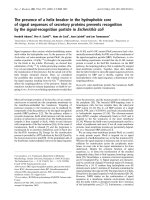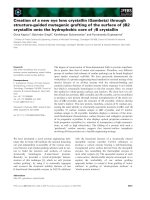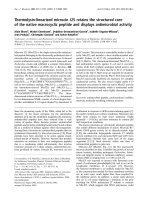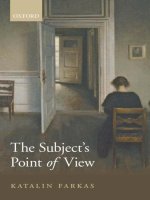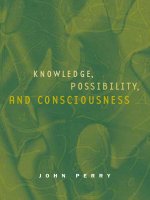the mit press the puppet and the dwarf the perverse core of christianity oct 2003
Bạn đang xem bản rút gọn của tài liệu. Xem và tải ngay bản đầy đủ của tài liệu tại đây (1.37 MB, 197 trang )
The Puppet and the Dwarf
Short Circuits
Slavoj Z
ˇ
izˇek, editor
The Puppet and the Dwarf:The Perverse Core of Christianity, by Slavoj Z
ˇ
izˇek
The Shortest Shadow:Nietzsche’s Philosophy of the Two, by Alenka Zupanicˇicˇ
The Puppet and the Dwarf
The Perverse Core of Christianity
Slavoj Z
ˇ
izˇek
The MIT Press Cambridge, Massachusetts London, England
© 2003 Massachusetts Institute of Technology
All rights reserved. No part of this book may be reproduced in any form by any
electronic or mechanical means (including photocopying, recording, or infor-
mation storage and retrieval) without permission in writing from the publisher.
This book was set in Joanna MT & Copperplate 33bc by Graphic Composition,
Inc.,Athens, GA, and was printed and bound in the United States of America.
Library of Congress Cataloging-in-Publication Data
Zizek, Slavoj.
The puppet and the dwarf : the perverse core of Christianity / Slavoj Zizek.
p. cm. — (Short circuits)
Includes bibliographical references (p. ).
ISBN 0-262-74025-7 (pbk. : alk. paper)
1. Christianity—Essence, genius, nature. 2. Historical materialism. I. Title.
II. Series.
BR121.3.Z59 2003
230—dc21
2003051043
Contents
Series Foreword vii
Introduction:The Puppet Called Theology 2
1 When East Meets West 12
2 The “Thrilling Romance of Orthodoxy” 34
3 The Swerve of the Real 58
4 From Law to Love . . . and Back 92
5 Subtraction, Jewish and Christian 122
Appendix: Ideology Today 144
Notes 173
This page intentionally left blank
Series Foreword
A short circuit occurs when there is a faulty connection in the net-
work—faulty, of course, from the standpoint of the network’s
smooth functioning. Is not the shock of short-circuiting, therefore,
one of the best metaphors for a critical reading? Is not one of the
most effective critical procedures to cross wires that do not usually
touch: to take a major classic (text, author, notion), and read it in a
short-circuiting way, through the lens of a “minor” author, text, or
conceptual apparatus (“minor” should be understood here in
Deleuze’s sense: not “of lesser quality,” but marginalized, disavowed
by the hegemonic ideology, or dealing with a “lower,” less dignified
topic)? If the minor reference is well chosen, such a procedure can
lead to insights which completely shatter and undermine our com-
mon perceptions.This is what Marx, among others, did with philos-
ophy and religion (short-circuiting philosophical speculation
through the lens of political economy, that is to say, economic spec-
ulation); this is what Freud and Nietzsche did with morality (short-
circuiting the highest ethical notions through the lens of the
unconscious libidinal economy).What such a reading achieves is not
a simple “desublimation,” a reduction of the higher intellectual con-
tent to its lower economic or libidinal cause; the aim of such an ap-
proach is, rather, the inherent decentering of the interpreted text,
which brings to light its “unthought,” its disavowed presuppositions
and consequences.
And this is what “Short Circuits” wants to do,again and again.The
underlying premise of the series is that Lacanian psychoanalysis is a
privileged instrument of such an approach, whose purpose is to il-
luminate a standard text or ideological formation,making it readable
in a totally new way—the long history of Lacanian interventions in
philosophy, religion, the arts (from the visual arts to the cinema, mu-
sic, and literature), ideology, and politics justifies this premise.This,
then, is not a new series of books on psychoanalysis, but a series of
“connections in the Freudian field”—of short Lacanian interven-
tions in art, philosophy, theology, and ideology.
“Short Circuits” intends to revive a practice of reading which
confronts a classic text, author, or notion with its own hidden pre-
suppositions, and thus reveals its disavowed truth.The basic criterion
for the texts that will be published is that they effectuate such a the-
oretical short circuit. After reading a book in this series, the reader
should not simply have learned something new: the point is, rather,
to make him or her aware of another—disturbing—side of some-
thing he or she knew all the time.
Slavoj Z
ˇ
izˇek
series foreword
The Puppet and the Dwarf
introduction
The Puppet Called Theology
Today, when the historical materialist analysis is receding, practiced
as it were under cover, rarely called by its proper name, while the
theological dimension is given a new lease on life in the guise of the
“postsecular” Messianic turn of deconstruction, the time has come
to reverse Walter Benjamin’s first thesis on the philosophy of history:
“The puppet called ‘theology’ is to win all the time. It can easily be
amatch for anyone if it enlists the service of historical materialism,
which today, as we know, is wizened and has to keep out of sight.”
One possible definition of modernity is: the social order in which
religion is no longer fully integrated into and identified with a par-
ticular cultural life-form, but acquires autonomy, so that it can sur-
vive as the same religion in different cultures.This extraction enables
religion to globalize itself (there are Christians, Muslims, and Bud-
dhists everywhere today); on the other hand, the price to be paid is
that religion is reduced to a secondary epiphenomenon with regard
to the secular functioning of the social totality. In this new global or-
der, religion has two possible roles: therapeutic or critical. It either helps
individuals to function better in the existing order, or it tries to as-
sert itself as a critical agency articulating what is wrong with this or-
der as such, a space for the voices of discontent—in this second case,
religion as such tends toward assuming the role of a heresy.The con-
tours of this deadlock were outlined by Hegel; sometimes, we find
in his work something I am tempted to call a “downward synthesis”:
after the two opposed positions, the third one, the Aufhebung of the
two, is not a higher synthesis bringing together what is worth main-
taining in the other two, but a kind of negative synthesis, the lowest
point. Here are three outstanding examples:
•
In the “logic of judgment,” the first triad of the “judgment of
existence” (positive-negative-infinite judgment) culminates in the
“infinite judgment”: God is not red, a rose is not an elephant, under-
standing is not a table—these judgments are, as Hegel puts it,“accu-
rate or true, as one calls them, but nonsensical and in bad taste.”
1
•
Twice in Phenomenology of Spirit. First apropos of phrenology, in which
the whole dialectic of the “observing Reason” culminates in the in-
finite judgment “the Spirit is a bone.”
2
3
•
Then, at the end of the chapter on Reason, in the passage to Spirit as
history, where we have the triad of the “law-giving Reason,” the
“law-testing Reason,” and the Reason that accepts its impenetrable
foundation. It is only by accepting the positivity of the law as its ul-
timate given background that we pass to history proper.The passage
to history proper occurs when we assume the failure of Reason re-
flectively to ground the laws that regulate the life of a people.
3
And it seems that the three modes of religion with which Glauben
undWissen and other early theological writings deal
4
form the same
triad:
•
The “people’s religion [Volksreligion]”—in Ancient Greece, religion was in-
trinsically bound up with a particular people, its life and customs. It
required no special reflexive act of faith: it was simply accepted.
•
The “positive religion”—imposed dogmas, rituals, rules, to be accepted
because they are prescribed by an earthly and/or divine authority
(Judaism, Catholicism).
•
The “religion of Reason”—what survives of religion when positive reli-
gion is submitted to the rational critique of Enlightenment.There are
two modes: Reason or Heart—either the Kantian dutiful moralist, or
the religion of pure interior feeling (Jacobi, etc.). Both dismiss the
positive religion (rituals, dogmas) as superficial historically condi-
tioned ballast. Crucial here is the inherent reversal of Kant into Ja-
cobi, of universalist moralism into pure irrational contingence of
feeling—that is to say, this immediate coincidence of opposites, this
direct reversal of reason into irrational belief.
Again, the passage from one moment to the next is clear: first, (the
people’s) religion loses its organic Naturwüchsigkeit, it changes into a
set of “alienated”—externally imposed and contingent—rules;
then, logically, the authority of these rules is to be questioned by our
Reason What,however,would constitute the step further that
would break the deadlock of universalist moralism and abstract feel-
ing converting directly into each other? There is no clear solution.
Why do we need religion at all in our modern times? The standard
answer is: rational philosophy or science is esoteric, confined to a
small circle; it cannot replace religion in its function of capturing the
imagination of the masses, and thus serving the purposes of moral
introduction
and political order. But this solution is problematic in Hegel’s own
terms: the problem is that, in the modern times of Reason, religion
can no longer fulfill this function of the organic binding force of so-
cial substance—today, religion has irretrievably lost this power not
only for scientists and philosophers, but also for the wider circle of
“ordinary” people. In his Lectures on Aesthetics, Hegel claims that in the
modern age, as much as we admire art, we no longer bend the knee
before it—and the same holds for religion.
Today, we live (in) the tension designated by Hegel even more
than people did in Hegel’s own times. When Hegel wrote: “It is a
modern folly to alter a corrupt ethical system, its constitution and
legislation, without changing the religion, to have a revolution with-
out a reformation,”
5
he announced the necessity of what Mao called
the “Cultural Revolution” as the condition of a successful social rev-
olution. Is this not what we have today: (the technological) revo-
lution without a fundamental “revolution of mores [Revolution der
Sitten]”? The basic tension is not so much the tension of reason ver-
sus feeling, but, rather, the tension of knowledge versus the dis-
avowed belief embodied in external ritual—the situation often
described in the terms of cynical reason whose formula, the reverse
of Marx’s, was proposed decades ago by Peter Sloterdijk: “I know
what I am doing; nonetheless, I am doing it. . . .”This formula,how-
ever, is not as unambiguous as it may appear—it should be supple-
mented with: “. . . because I don’t know what I believe.”
In our politically correct times, it is always advisable to start with
the set of unwritten prohibitions that define the positions one is
allowed to adopt.The first thing to note with regard to religious mat-
ters is that reference to “deep spirituality” is in again: direct materi-
alism is out; one is, rather, enjoined to harbor openness toward a
radical Otherness beyond the ontotheological God. Consequently,
when, today, one directly asks an intellectual: “OK, let’s cut the crap
and get down to basics: do you believe in some form of the divine
or not?,” the first answer is an embarrassed withdrawal, as if the
question is too intimate, too probing; this withdrawal is then usually
explained in more “theoretical” terms: “That is the wrong question
5
to ask! It is not simply a matter of believing or not, but, rather, a
matter of certain radical experience, of the ability to open oneself
to a certain unheard-of dimension, of the way our openness to rad-
ical Otherness allows us to adopt a specific ethical stance, to expe-
rience a shattering form of enjoyment ”What we are getting
today is a kind of “suspended” belief, a belief that can thrive only as
not fully (publicly) admitted, as a private obscene secret. Against
this attitude, one should insist even more emphatically that the
“vulgar” question “Do you really believe or not?” matters—more
than ever, perhaps. My claim here is not merely that I am a ma-
terialist through and through, and that the subversive kernel of
Christianity is accessible also to a materialist approach; my thesis
is much stronger: this kernel is accessible only to a materialist ap-
proach—and vice versa: to become a true dialectical materialist,
one should go through the Christian experience.
6
Was there, however, at any time in the past, an era when people
directly “really believed”? As Robert Pfaller demonstrated in Illusionen
der Anderen,
7
the direct belief in a truth that is subjectively fully as-
sumed (“Here I stand!”) is a modern phenomenon, in contrast to
traditional beliefs-through-distance, like politeness or rituals. Pre-
modern societies did not believe directly, but through distance,
and this explains, for instance, why Enlightenment critics misread
“primitive” myths—they first took the notion that a tribe originated
from a fish or a bird as a literal direct belief, then rejected it as stu-
pid,“fetishist,” naive.They thereby imposed their own notion of be-
lief on the “primitivized” Other. (Is this not also the paradox of Edith
Wharton’s The Age of Innocence? Newton’s wife was not a naive (“inno-
cent”) believer in her husband’s fidelity—she was well aware of his
passionate love for Countess Olenska, she just politely ignored it, and
acted as if she believed in his fidelity ) Pfaller is right to empha-
size how, today, we believe more than ever: the most skeptical atti-
tude, that of deconstruction, relies on the figure of an Other who
“really believes”; the postmodern need for the permanent use of the
devices of ironic distantiation (quotation marks, etc.) betrays the
the puppet called theology
underlying fear that, without these devices, belief would be direct
and immediate—as if, if I were to say “I love you” instead of the
ironic “As the poets would have put it, I love you,” this would entail
a directly assumed belief that I love you—that is, as if a distance is
not already operative in the direct statement “I love you’’ . . .
And perhaps that is where we find the stake of today’s reference
to “culture,” of “culture” emerging as the central life-world cate-
gory.When it comes to religion, for example, we no longer “really
believe” today, we just follow (some) religious rituals and mores as
part of respect for the “lifestyle” of the community to which we be-
long (nonbelieving Jews obeying kosher rules “out of respect for tra-
dition,” etc.). “I don’t really believe in it, it’s just part of my culture”
effectively seems to be the predominant mode of the disavowed/
displaced belief characteristic of our times.What is a cultural lifestyle,
if not the fact that, although we don’t believe in Santa Claus, there is
a Christmas tree in every house, and even in public places, every
December? Perhaps, then, the “nonfundamentalist” notion of “cul-
ture” as distinguished from “real” religion, art, and so on, is in its
very core the name for the field of disowned/impersonal beliefs—
“culture” is the name for all those things we practice without really
believing in them, without “taking them seriously.” Is this not also
why science is not part of this notion of culture—it is all too real?
And is this also not why we dismiss fundamentalist believers as “bar-
barians,” as anticultural, as a threat to culture—they dare to take their
beliefs seriously? Today, we ultimately perceive as a threat to culture
those who live their culture immediately, those who lack a distance
toward it. Recall the outrage when, two years ago, the Taliban forces
in Afghanistan destroyed the ancient Buddhist statues at Bamiyan: al-
though none of us enlightened Westerners believe in the divinity of
the Buddha, we were outraged because the Taliban Muslims did not
show the appropriate respect for the “cultural heritage” of their own
country and the entire world. Instead of believing through the other,
like all people of culture, they really believed in their own religion,
and thus had no great sensitivity toward the cultural value of the
7
monuments of other religions—to them, the Buddha statues were
just fake idols, not “cultural treasures.”
One commonplace about philosophers today is that their very
analysis of the hypocrisy of the dominant system betrays their
naivety: why are they still shocked to see people inconsistently vio-
late their professed values when it suits their interests? Do they really
expect people to be consistent and principled? Here one should de-
fend authentic philosophers: what surprises them is the exact oppo-
site—not that people do not “really believe,” and act upon their
professed principles, but that people who profess their cynical distance and rad-
ical pragmatic opportunism secretly believe much more than they are willing to admit,
even if they transpose these beliefs onto (nonexistent) “others.”
Within this framework of suspended belief, three so-called
“postsecular” options are permitted: one is allowed either to praise
the wealth of polytheistic premodern religions oppressed by the
Judeo-Christian patriarchal legacy; or to stick to the uniqueness of
the Jewish legacy, to its fidelity to the encounter with radical Other-
ness, in contrast to Christianity.Here, I would like to make myself ab-
solutely clear: I do not think that the present vague spiritualism, the
focus on the openness to Otherness and its unconditional Call, this
mode in which Judaism has become almost the hegemonic ethico-
spiritual attitude of today’s intellectuals, is in itself the “natural”
form of what one can designate, in traditional terms, as Jewish spir-
ituality. I am almost tempted to claim that we are dealing here with
something that is homologous to the Gnostic heresy of Christianity,
and that the ultimate victim of this Pyrrhic “victory” of Judaism will
be the most precious elements of Jewish spirituality itself, with their
focus on a unique collective experience.Who today remembers the
kibbutz, the greatest proof that Jews are not “by nature” financial
middlemen?
In addition to these two options, the only Christian references
permitted are the Gnostic or mystical traditions that had to be ex-
cluded and repressed in order for the hegemonic figure of Chris-
tianity to install itself. Christ himself is OK if we try to isolate the
introduction
“original” Christ, “the Rabbi Jesus” not yet inscribed into the Chris-
tian tradition proper—Agnes Heller speaks ironically of the “resur-
rection of the Jewish Jesus”: our task today is to resurrect the true
Jesus from the mystifying Christian tradition of Jesus (as) Christ.
8
All
this makes a positive reference to Saint Paul a very delicate issue: is
he not the very symbol of the establishment of Christian orthodoxy?
In the last decade, nonetheless, one small opening has appeared, a
kind of exchange offered between the lines: one is allowed to praise
Paul, if one reinscribes him back into the Jewish legacy—Paul as a
radical Jew, an author of Jewish political theology
While I agree with this approach, I want to emphasize how, if it
is taken seriously, its consequences are much more catastrophic
than they may appear.When one reads Saint Paul’s epistles, one can-
not fail to notice how thoroughly and terribly indifferent he is toward
Jesus as a living person (the Jesus who is not yet Christ, the pre-
Easter Jesus, the Jesus of the Gospels)—Paul more or less totally ig-
nores Jesus’ particular acts, teachings, parables, all that Hegel later
referred to as the mythical element of the fairytale narrative, of the
mere prenotional representation [Vorstellung]; never in his writings
does he engage in hermeneutics, in probing into the “deeper mean-
ing” of this or that parable or act of Jesus.What matters to him is not
Jesus as a historical figure, only the fact that he died on the Cross and
rose from the dead—after confirming Jesus’ death and resurrection,
Paul goes on to his true Leninist business, that of organizing the new
party called the Christian community. Paul as a Leninist: was not
Paul, like Lenin, the great “institutionalizer,” and, as such, reviled by
the partisans of “original” Marxism-Christianity? Does not the
Pauline temporality “already, but not yet” also designate Lenin’s sit-
uation in between the two revolutions, between February and Octo-
ber 1917? Revolution is already behind us, the old regime is out,
freedom is here—but the hard work still lies ahead.
In 1956, Lacan proposed a short and clear definition of the Holy
Spirit: “The Holy Spirit is the entry of the signifier into the world.
This is certainly what Freud brought us under the title of death
9
drive.”
9
What Lacan means, at this moment of his thought, is that the
Holy Spirit stands for the symbolic order as that which cancels (or,
rather, suspends) the entire domain of “life”—lived experience, the
libidinal flux, the wealth of emotions, or, to put it in Kant’s terms,
the “pathological.”When we locate ourselves within the Holy Spirit,
we are transubstantiated, we enter another life beyond the biologi-
cal one.And is not this Pauline notion of life grounded in Paul’s other
distinctive feature? What enabled him to formulate the basic tenets
of Christianity, to elevate Christianity from a Jewish sect into a uni-
versal religion (religion of universality), was the very fact that he was
not part of Christ’s “inner circle.” One can imagine the inner circle
of apostles reminiscing during their dinner conversations: “Do you
remember how, at the Last Supper, Jesus asked me to pass the salt?”
None of this applies to Paul: he is outside and, as such, symbolically
substituting for (taking the place of ) Judas himself among the
apostles. In a way, Paul also “betrayed” Christ by not caring about his
idiosyncrasies, by ruthlessly reducing him to the fundamentals, with
no patience for his wisdom, miracles, and similar paraphernalia.
So yes, one should read Paul from within the Jewish tradition—
since precisely such a reading brings home the true radicality of his
break, the way he undermined the Jewish tradition from within.
To use a well-known Kierkegaardian opposition: reading Saint Paul
from within the Jewish tradition, as the one located in it, allows us
to grasp “Christianity-in-becoming”: not yet the established posi-
tive dogma, but the violent gesture of positing it, the “vanishing
mediator” between Judaism and Christianity, something akin to
Benjaminian law-constituting violence. In other words, what is ef-
fectively “repressed” with the established Christian doxa is not so
much its Jewish roots, its indebtedness to Judaism, but, rather, the
break itself, the true location of Christianity’s rupture with Judaism.
Paul did not simply pass from the Jewish position to another posi-
tion; he did something with, within, and to the Jewish position it-
self—what?
the puppet called theology
This page intentionally left blank
chapter 1
When East Meets West
A proper starting point would have been to ask the Schellingian
question: what does the becoming-man of God in the figure of
Christ, His descent from eternity to the temporal realm of our real-
ity, mean for God Himself? What if that which appears to us, finite
mortals, as God’s descent toward us, is, from the standpoint of God
Himself, an ascent? What if, as Schelling implied, eternity is less than
temporality? What if eternity is a sterile, impotent, lifeless domain of
pure potentialities, which, in order fully to actualize itself, has to
pass through temporal existence? What if God’s descent to man, far
from being an act of grace toward humanity, is the only way for God
to gain full actuality, and to liberate Himself from the suffocating
constraints of Eternity? What if God actualizes Himself only through
human recognition?
1
We have to get rid of the old Platonic topos of love as Eros that grad-
ually elevates itself from love for a particular individual, through
love for the beauty of a human body in general and the love of the
beautiful form as such, to love for the supreme Good beyond all
forms: true love is precisely the opposite move of forsaking the promise
of Eternity itself for an imperfect individual. (This lure of eternity can take
many forms, from postmortal Fame to fulfilling one’s social role.)
What if the gesture of choosing temporal existence, of giving up
eternal existence for the sake of love—from Christ to Siegmund in
Act II of Wagner’s Die Walküre, who prefers to remain a common mor-
tal if his beloved Sieglinde cannot follow him to Valhalla, the eternal
dwelling-place of dead heroes—is the highest ethical act of them all?
The shattered Brünnhilde comments on this refusal: “So little do you
value everlasting bliss? Is she everything to you, this poor woman
who, tired and sorrowful, lies limp in your lap? Do you think noth-
ing less glorious?” Ernst Bloch was right to observe that what is lack-
ing in German history are more gestures like Siegmund’s.
We usually claim that time is the ultimate prison (“no one can
jump outside of his/her time”), and that the whole of philosophy
and religion circulates around one aim: to break out of this prison-
house of time into eternity.What, however, if, as Schelling implies,
13
eternity is the ultimate prison, a suffocating closure, and it is only the
fall into time that introduces Opening into human experience? Is
Time not the name for the ontological opening? The Event of “incar-
nation” is thus not so much the time when ordinary temporal real-
ity touches Eternity, but, rather, the time when Eternity reaches into
time.This same point has been made very clearly by intelligent con-
servatives like G. K. Chesterton (like Hitchcock, an English Catholic),
who wrote, apropos of the fashionable claim about the “alleged spir-
itual identity of Buddhism and Christianity”:
Love desires personality; therefore love desires division. It is the in-
stinct of Christianity to be glad that God has broken the universe into
little pieces This is the intellectual abyss between Buddhism and
Christianity; what for the Buddhist or Theosophist personality is the
fall of man, for the Christian is the purpose of God, the whole point
of his cosmic idea. The world-soul of the Theosophists asks man to
love it only in order that man may throw himself into it. But the di-
vine centre of Christianity actually threw man out of it in order that
he might love it All modern philosophies are chains which con-
nect and fetter; Christianity is a sword which separates and sets free.
No other philosophy makes God actually rejoice in the separation of
the universe into living souls.
2
And Chesterton is fully aware that it is not enough for God to sepa-
rate man from Himself so that mankind will love Him—this sepa-
ration has to be reflected back into God Himself, so that God is
abandoned by himself:
When the world shook and the sun was wiped out of heaven, it was
not at the crucifixion, but at the cry from the cross: the cry which
confessed that God was forsaken of God.And now let the revolution-
ists choose a creed from all the creeds and a god from all the gods of
the world, carefully weighing all the gods of inevitable recurrence
and of unalterable power. They will not find another god who has
himself been in revolt. Nay (the matter grows too difficult for human
speech), but let the atheists themselves choose a god.They will find
only one divinity who ever uttered their isolation; only one religion
in which God seemed for an instant to be an atheist.
3
chapter 1
Because of this overlapping between man’s isolation from God and
God’s isolation from himself, Christianity is
terribly revolutionary.That a good man may have his back to the wall
is no more than we knew already; but that God could have His back
to the wall is a boast for all insurgents for ever. Christianity is the only
religion on earth that has felt that omnipotence made God incom-
plete. Christianity alone has felt that God, to be wholly God, must
have been a rebel as well as a king.
4
Chesterton is fully aware that we are thereby approaching “a matter
more dark and awful than it is easy to discuss . . . a matter which the
greatest saints and thinkers have justly feared to approach. But in that
terrific tale of the Passion there is a distinct emotional suggestion
that the author of all things (in some unthinkable way) went not
only through agony, but through doubt.”
5
In the standard form of
atheism, God dies for men who stop believing in Him; in Christian-
ity, God dies for Himself. In his “Father, why hast thou forsaken me?,”
Christ himself commits what is, for a Christian, the ultimate sin: he
wavers in his Faith.
This “matter more dark and awful than it is easy to discuss”
concerns what cannot but appear as the hidden perverse core of
Christianity: if it is prohibited to eat from the Tree of Knowledge in
Paradise, why did God put it there in the first place? Is it not that this
was a part of His perverse strategy first to seduce Adam and Eve into
the Fall, in order then to save them? That is to say: should one not ap-
ply Paul’s insight into how the prohibitive law creates sin to this very
first prohibition also? A similar obscure ambiguity surrounds the
role of Judas in Christ’s death: since his betrayal was necessary to his
mission (to redeem humanity through his death on the Cross), did
Christ not need it? Are his ominous words during the Last Supper not
a secret injunction to Judas to betray him? “Judas, who betrayed
him, said, ‘Surely not I, Rabbi?’ He replied, ‘You have said so’”
(Matthew 26:25).The rhetorical figure of Christ’s reply is, of course,
that of disavowed injunction: Judas is interpellated as the one who
will hand Christ over to the authorities—not directly (“You are the
15
one who will betray me!”), but so that the responsibility is put onto
the other. Is Judas not therefore the ultimate hero of the New Tes-
tament, the one who was ready to lose his soul and accept eternal
damnation so that the divine plan could be accomplished?
6
In all other religions, God demands that His followers remain
faithful to Him—only Christ asked his followers to betray him in or-
der to fulfill his mission. Here I am tempted to claim that the entire
fate of Christianity, its innermost kernel, hinges on the possibility of
interpreting this act in a nonperverse way.That is to say: the obvious
reading that imposes itself is a perverse one—even as he lamented
the forthcoming betrayal, Christ was, between the lines, giving the
injunction to Judas to betray him, demanding of him the highest
sacrifice—the sacrifice not only of his life, but also of his “second
life,” of his posthumous reputation. The problem, the dark ethical
knot in this affair, is thus not Judas, but Christ himself: in order to
fulfill his mission, was he obliged to have recourse to such obscure,
arch-Stalinist manipulation? Or is it possible to read the relationship
between Judas and Christ in a different way, outside this perverse
economy?
In January 2002, a weird Freudian slip occurred in Lauderhill,
Florida: a plaque, prepared to honor the actor James Earl Jones at a
celebration of Martin Luther King, instead bore this inscription:
“Thank you James Earl Ray for keeping the dream alive”—a refer-
ence to King’s famous “I have a dream” speech. It is common knowl-
edge that Ray was the man convicted of assassinating King in 1968.
Of course, this was in all probability a rather elementary racist slip—
however, there is a strange truth in it: Ray, in effect, contributed to
keeping the King dream alive, on two different levels. First, part of
the heroic larger-than-life image of Martin Luther King is his violent
death: without this death, he would definitely not have become the
symbol that he is now, with streets named after him and his birthday
a national holiday. Even more concretely, one can argue that King
died at exactly the right moment: in the weeks before his death, he
moved toward a more radical anticapitalism, supporting strikes by
black and white workers—had he moved further in this direction,
when east meets west

